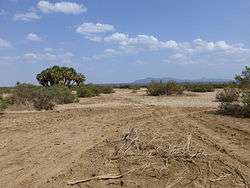Ledi-Geraru
| Ledi-Geraru | |
|---|---|
| Paleoanthropological site | |
 A view in the Afar Region, which contains the Ledi-Geraru site | |
| Coordinates: 11°21′N 40°52′E / 11.350°N 40.867°ECoordinates: 11°21′N 40°52′E / 11.350°N 40.867°E(approximate) | |
| Country | Ethiopia |
| Region | Afar |
The Ledi-Geraru Research Project is located in northeastern Ethiopia between the river basins of the Awash and the Mille. The oldest fossil from the human genus Homo, the mandible known as LD 350-1, was found at this site in 2013.[1] The fossil was discovered by Chalachew Seyoum, an Ethiopian graduate student in the Institute of Human Origins at Arizona State University. This site is just a dozen miles from where Lucy was discovered in 1974.
The first field expedition to the area was conducted in 2002 after earlier research in 1972-1974.[2] A fossilized hippopotamus mandible was also found at the site.[3]
LD 350-1
LD 350-1 is a fossil hominin mandible fragment discovered in 2013 at the Ledi-Geraru site. It was stratigraphically dated to 2.80 to 2.75 million years old.[4]
It has been described as combining "primitive traits seen in early Australopithecus with derived morphology observed in later Homo.[5]
The fossil is the left mandibular body, but does not include the ascending ramus. It has attached the three molars, both premolars, and the left canine, some of which have complete crowns. Based on the morphology, it was classified as belonging to the genus Homo, although Australopithecus afarensis has been found in the same area.[5]
References
- ↑ Shreeve, Jamie. "Oldest Human Fossil Found, Redrawing Family Tree". National Geographic. Retrieved 5 August 2015.
- ↑ "Ledi-Geraru Research Project". ASU. Retrieved 5 August 2015.
- ↑ Jeanna Bryner. "Earliest Known Human Fossils Discovered". Livescience.com. Retrieved 5 August 2015.
- ↑ Villmoare et al. (2015): "The Gurumaha Tuff is radiometrically dated to 2.842±0.007 Ma, a date that is consistent with the normal magnetic polarity of the Gurumaha section, presumably the Gauss Chron. An upper bounding age for LD 350-1 is provided by an adjacent, downfaulted younger block that contains the 2.665±0.016 Ma Lee Adoyta Tuff. [...] the age of LD 350-1 can be further constrained by stratigraphic scaling. [...] Based on the current chronostratigraphic framework for Ledi-Geraru, we consider the age of LD 350-1 to be 2.80-2.75 Ma". See also: DiMaggio, Erin N.; Campisano, Christopher J.; Rowan, John; Dupont-Nivet, Guillaume; Deino, Alan L.; Bibi, Faysal; Lewis, Margaret E.; Souron, Antoine; Garello, Dominique; Werdelin, Lars; Reed, Kaye E.; Arrowsmith, J Ramón (20 Mar 2015). "Late Pliocene fossiliferous sedimentary record and the environmental context of early Homo from Afar, Ethiopia". Science. 347: 1355–1359. doi:10.1126/science.aaa1415. PMID 25739409.
- 1 2 Villmoare, Brian; Kimbel, William H.; Seyoum, Chalachew; Campisano, Christopher J.; DiMaggio, Erin N.; Rowan, John; Braun, David R.; Arrowsmith, J. Ramón; Reed, Kaye E. (2015-03-20). "Early Homo at 2.8 Ma from Ledi-Geraru, Afar, Ethiopia". Science. 347 (6228): 1352–1355. Bibcode:2015Sci...347.1352V. doi:10.1126/science.aaa1343. ISSN 0036-8075. PMID 25739410. . See also: Erin N. DiMaggio EN; Campisano CJ; Rowan J; Dupont-Nivet G; Deino AL; et al. (2015). "Late Pliocene fossiliferous sedimentary record and the environmental context of early Homo from Afar, Ethiopia". Science. 347: 1355–1359. Bibcode:2015Sci...347.1355D. doi:10.1126/science.aaa1415. PMID 25739409. .